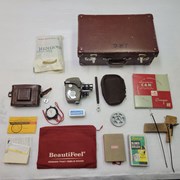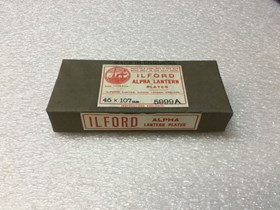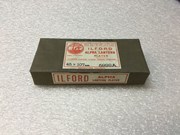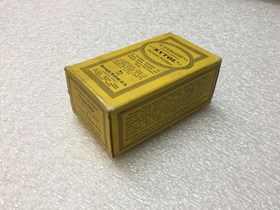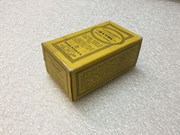Narrow Results By
Camera; Equipment Case
https://archives.whyte.org/en/permalink/artifact104.41.0287a-m
- Date
- 2024
- Catalogue Number
- 104.41.0287a-m
- Description
- Custom red brown camera case containing a camera, recorder, and various equipment and accessories.a) Red brown suitcase that has been customized to carry cameras and their equipment. The outside has reinforced leather corners and silver hardware. The outside has the initials “J. R. G.” on the top a…
1 image
- Title
- Camera; Equipment Case
- Date
- 2024
- Dimensions
- 13.5 x 41.0 cm
- Description
- Custom red brown camera case containing a camera, recorder, and various equipment and accessories.a) Red brown suitcase that has been customized to carry cameras and their equipment. The outside has reinforced leather corners and silver hardware. The outside has the initials “J. R. G.” on the top and bottom sides, as well as under the handle. Inside, the case has a brown plaid lining. The bottom of the case has been fitted with a custom made wood, cream coloured apparatus that is designed to hold (c). It comes apart into two pieces - the base, which is not removable, and the lid, which slides out to the right once it has been unhooked from the latch built into the base n the left hand side. The lid of the suitcase reads “J. R. GRICE / 9920 - 75 ST / EDMONTON / ALBERTA”. The foam on the apparatus has worn off, leaving black dust like particles in the suitcase. There are a set of two keys hanging from a brown strap connecting the lid to the base in the center of the suitcase.b) Silver and black camera in a brown leather case. The camera is secured in the case with a wide, flat screw at the base. The camera also comes with its original document outlining the features and instructions of the camera. The camera itself is a Olympus Chrome Six. According to the document, the camera was used to produce “ (12) 6x6cm photos or (16) 4.5x6cm photos on a roll of 120 film”. The camera is black leather with a silver body. There are two silver knobs on the base. The top has four knobs, a viewfinder, and a mount for flash. The smallest knob next to the viewfinder is used to release the lens, which opens from a square panel in the front. The lens is a coated Olympus Zuiko lens. The brown case is Olympus brand and is custom fitted to the camera model. It opens from the top and has two snaps that secure it to the base of the case. A small flap can be opened to allow the camera to be used while remaining in the case. The strap that connects the top of the case to the bottom reads “J. R. GRICE / 9920 - 75 ST / EDMONTON / ALBERTA”. There is a short, thin strap that attaches to either side of the case by metal hardware - one side is broken, the leather has split. The case shows some wear - the connecting middle strap has a large horizontal tear at the seam, while the lens flap has a smaller horizontal tear on the right hand side. c) Green, silver and black recorder that has a strap, brown cloth case and spare reel. The brand on the case, recorder and strap is labeled as Sankyo. The recorder is a muted green colour, with black and silver components. It has three lenses on the front with metal lens caps, The viewfinder is clear. The strap is made of silver components and brown braided cord. The case is brown cloth with a gold zipper, with Sankyo Japan embossed on the side. The reel is made of grey plastic and branded as Kodak, but is believed to work with the recorder. d) Black and white stop watch on a red cord. Was likely used to time exposure times. e) Viewfinder in its original box. Brand is “Watameter”.f) Light meter on a silver snake-chain in its original box. Still operable.g) Blower brush in its original box. h) Handmade camera mount made from wood with attached trigger. There is also a spare trigger wire. i) Film reel it its original box. Reel is empty.j) Bag of miscellaneous bulbs, two of which are for a Sylvanus projector. One is brand new in box. k) Red cloth bag. Front reads “BeautifFeel / Design that feels good” while the bottom says “every woman deserves a pair”l) Miscellaneous papers detailing movie film features and instructions. Have been folded, so they are creased.
- Credit
- Gift of Janet Grice, Banff, 2024
- Catalogue Number
- 104.41.0287a-m
Images
This material is presented as originally created; it may contain outdated cultural descriptions and
potentially offensive content.
Read more.
- Date
- 1883 – 1926
- Material
- cardboard; metal; glass;
- Catalogue Number
- 104.41.0129 a,b
- Description
- Two camera lenses housed in a repurposed Hammond box with “OLD ‘ADON’ Telephoto in shutter circa 1990’s” written in black ink on the front.The larger lens with shutter was manufactured by Bausch & Lomb Optical Co., originally a company that produced prescription eye-wear in the mid to late-1800s be…
1 image
- Title
- Camera Lenses
- Date
- 1883 – 1926
- Material
- cardboard; metal; glass;
- Dimensions
- 5.7 x 7.8 x 14.5 cm
- Description
- Two camera lenses housed in a repurposed Hammond box with “OLD ‘ADON’ Telephoto in shutter circa 1990’s” written in black ink on the front.The larger lens with shutter was manufactured by Bausch & Lomb Optical Co., originally a company that produced prescription eye-wear in the mid to late-1800s before expanding into camera lenses and microscopes/telescopes towards the turn of the century. The company was founded in Rochester NY.The smaller lens was manufactured by Gundlach-Manhattan Optical Co., a merged company between Gundlach Optical Co. and Manhattan Optical Co. that took place in 1902, which produced various kinds of bellows cameras. Both companies were based in Rochester NY prior to merging.
- Credit
- Gift of Nicholas Morant, Banff, 2006
- Catalogue Number
- 104.41.0129 a,b
Images
This material is presented as originally created; it may contain outdated cultural descriptions and
potentially offensive content.
Read more.
Lantern Plates
https://archives.whyte.org/en/permalink/artifact104.41.0206
- Date
- 1889 – 1910
- Material
- paper; glass;
- Catalogue Number
- 104.41.0206
- Description
- One paper-wrapped package of 45x107mm Ilford Alpha Lantern Plates with white and red paper adhesive labels on the top and front of the package containing manufacturer details. These lantern plates would serve as the positive mount for the lantern slide made from the original negative. Lantern slide…
1 image
- Title
- Lantern Plates
- Date
- 1889 – 1910
- Material
- paper; glass;
- Dimensions
- 2.0 x 11.6 x 5.3 cm
- Description
- One paper-wrapped package of 45x107mm Ilford Alpha Lantern Plates with white and red paper adhesive labels on the top and front of the package containing manufacturer details. These lantern plates would serve as the positive mount for the lantern slide made from the original negative. Lantern slides are glass-based transparencies that were displayed by being projected through an early projector called a magic lantern. Starting as hand-painted images on glass, lantern slides quickly adapted to first black-and-white and then colour photography and faded from popularity with the rise of celluloid film and motion pictures.
- Credit
- Gift of Robert Crosby Family, Banff, 1998
- Catalogue Number
- 104.41.0206
Images
This material is presented as originally created; it may contain outdated cultural descriptions and
potentially offensive content.
Read more.
Photograph Developer
https://archives.whyte.org/en/permalink/artifact104.41.0203
- Date
- 1880 – 1940
- Material
- cardboard;
- Catalogue Number
- 104.41.0203
- Description
- Empty cardboard box of Burroughs Wellcome & Co. ‘Tabloid’ (Photographic) ‘Rytol’ Universal Developer that could be used on plates, film, bromide and gaslight papers, and glass lantern slides. Directions on how to use the developer are printed in black throughout the yellow box. Developers were eith…
1 image
- Title
- Photograph Developer
- Date
- 1880 – 1940
- Material
- cardboard;
- Dimensions
- 9.0 x 4.0 x 5.1 cm
- Description
- Empty cardboard box of Burroughs Wellcome & Co. ‘Tabloid’ (Photographic) ‘Rytol’ Universal Developer that could be used on plates, film, bromide and gaslight papers, and glass lantern slides. Directions on how to use the developer are printed in black throughout the yellow box. Developers were either chemical powders or liquids that would be added to another agent [usually a bath] to create a solution that would then be used to expose the positive photograph after it had been transferred from the original negative. Different concentrations or chemicals used could yield different results, usually in regards to contrast and colour of the finished image, depending on the photographic base.
- Credit
- Gift of Robert Crosby Family, Banff, 1998
- Catalogue Number
- 104.41.0203
Images
This material is presented as originally created; it may contain outdated cultural descriptions and
potentially offensive content.
Read more.


